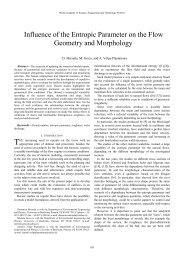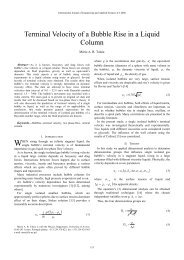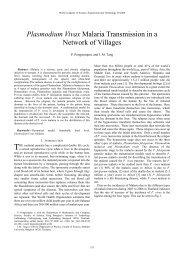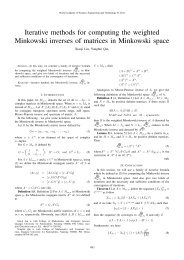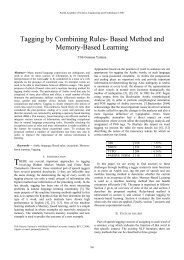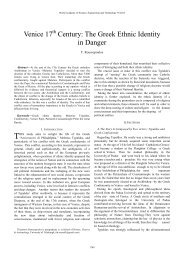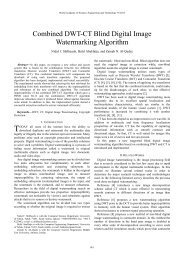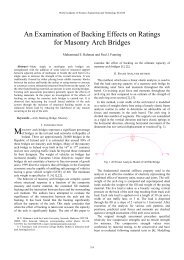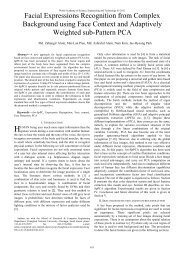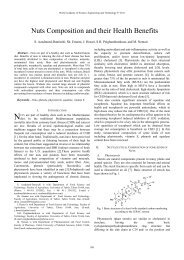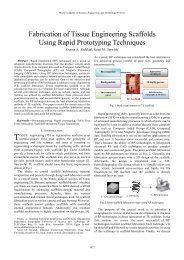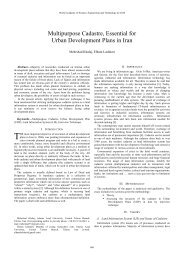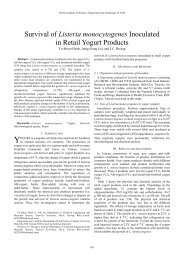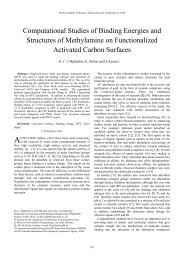Comparison of Physico-Chemical Properties And Fatty Acid ...
Comparison of Physico-Chemical Properties And Fatty Acid ...
Comparison of Physico-Chemical Properties And Fatty Acid ...
Create successful ePaper yourself
Turn your PDF publications into a flip-book with our unique Google optimized e-Paper software.
<strong>Comparison</strong> <strong>of</strong> <strong>Physico</strong>-<strong>Chemical</strong> <strong>Properties</strong><br />
<strong>And</strong> <strong>Fatty</strong> <strong>Acid</strong> Compostion <strong>of</strong><br />
Elateriospermum Tapos (Buah Perah), Palm Oil<br />
<strong>And</strong> Soybean Oil<br />
Abstract—Elateriospermum tapos seed (buah perah) is the one<br />
<strong>of</strong> the rich sources <strong>of</strong> polyunsaturated fatty acids. It contains high<br />
percentage <strong>of</strong> oleic acid which is the important component to develop<br />
nervous system and also α-linolenic acid (ALA) which is the<br />
precursor <strong>of</strong> omega-3 fatty acids series to synthesize<br />
eicosapentaenoic acid (EPA) and docosahexaenoic acid (DHA).<br />
However, there is less study about this valuable oilseed and exploit<br />
its potential. Therefore, this paper is to assess the comparison <strong>of</strong><br />
physico-chemical properties and fatty composition <strong>of</strong> perah oil to<br />
palm oil and soybean oil. From the comparison, perah oil shows low<br />
peroxide value means it has good oxidative stability and also high<br />
iodine values shows that it can be used in paint industry. The study<br />
shown that perah oil is comparable to palm oil and soybean oil, so it<br />
has high potential to be exploited in the oleochemical,<br />
pharmaceutical, cosmetics and paint industries.<br />
Keywords— α-linolenic acid, palm oil, perah oil, soybean oil<br />
I. INTRODUCTION<br />
VER the past 20 years, there has been a dramatic increase<br />
Oin<br />
the scientific scrutiny <strong>of</strong> and public interest in omega-3<br />
and omega-6 fatty acids and their impact on personal<br />
health[1]. The precursor <strong>of</strong> omega-3 fatty acid is α-linolenic<br />
acid (C18:3n-3, ALA) while the precursor <strong>of</strong> omega-6 fatty<br />
acid is linoleic acid (C18:2n-6, LA). Eicosapentaenoic acid<br />
(EPA) and docosahexaenoic acid (DHA) are converted from<br />
the ALA which cannot be synthesized by human, so they are<br />
also known as essential fatty acids. Nowadays, consumption<br />
<strong>of</strong> fish or fish oil appears to play an important role in<br />
supplying the omega-3 polyunsaturated fatty acid (PUFA) for<br />
human health. The fish species rich in omega-3 PUFAs are<br />
anchovy (European), bass (stripped), bluefish, mackerel<br />
(Atlantic),herring (Atlantic and Pacific), pompano (Florida),<br />
salmon (Atlantic, Chinook, Pink and Sockeye), sardines, trout<br />
(Lake and Rainbow), sablefish and tuna [2]. They provide an<br />
Siti Hamidah is with the Faculty <strong>of</strong> <strong>Chemical</strong> and Natural Resources<br />
Engineering, Universiti Teknologi Malysia, 81310 Skudai, Johor. (phone: 07-<br />
5535496; fax: 07-5581463; e-mail: sitihamidah@cheme.utm.my).<br />
Lee Nian Yian is with Faculty <strong>of</strong> <strong>Chemical</strong> and Natural Resources<br />
Engineering, Universiti Teknologi Malysia, 81310 Skudai, Johor. (e-mail:<br />
nianyian913@gmail.com).<br />
Azizi Mohd is with Centre <strong>of</strong> Lipids Engineering and Applied Research<br />
(CLEAR) Laboratory, Department <strong>of</strong> <strong>Chemical</strong> Engineering, the Faculty <strong>of</strong><br />
<strong>Chemical</strong> and Natural Resources Engineering, Universiti Teknologi Malysia,<br />
81310 Skudai, Johor. (e-mail:azizi@cheme.utm.my).<br />
World Academy <strong>of</strong> Science, Engineering and Technology 57 2011<br />
Siti Hamidah, Lee Nian Yian, Azizi Mohd<br />
855<br />
adequate amount <strong>of</strong> omega-3 PUFAs (2.7-7.5g per meal) and<br />
appear to meet the nutritional recommendations <strong>of</strong> the<br />
American Heart Association [3]. However, the safety issue in<br />
consumption <strong>of</strong> fish should be taking in consideration even<br />
though fish can supply DHA, EPA, certain minerals and<br />
vitamins. The potential health risk related to the consumption<br />
<strong>of</strong> fish may be because <strong>of</strong> the presence <strong>of</strong> some environmental<br />
contaminants which are carcinogenic or non-carcinogenic<br />
such as polychlorinated biphenyls (PCBs), heptachlor, methyl<br />
mercury, dioxin and so forth in some species <strong>of</strong> fish. Even<br />
though these substances are present in low levels in fresh<br />
water such as lakes, rivers and oceans (sea water) but it can be<br />
accumulated into aquatic food chain through bioconcentration<br />
and biomagnification. As we know that, human will be<br />
exposed to these all environmental contaminants is through<br />
the utilization <strong>of</strong> fish on frequent basis. Among all the<br />
contaminants as mentioned above, polychlorinated biphenyls<br />
and methylmercury have the longer half lives in humans’<br />
bodies. The accumulated methyl mercury will be stored in<br />
muscles while the fat soluble environmental contaminants<br />
such as PCBs are stored in adipose tissue <strong>of</strong> the body. The<br />
PCBs amount can be reduced by remove the skin <strong>of</strong> fish and<br />
fat before cooking, but the methyl mercury cannot be removed<br />
like PCBs through skinning and trimming [3]. Therefore,<br />
consumption <strong>of</strong> fish may carry risk to pregnant women,<br />
children and older men. In addition, since fish oil always<br />
presents higher amounts <strong>of</strong> omega-3 fatty acids than seed oils<br />
or microalgae, fish therefore, has become a valuable product<br />
not only as a valuable ingredients itself in omega-3 enriched<br />
products[4]. It is known that the global fish stocks are in<br />
danger, so there might be a decrease in fish supply in the<br />
future.<br />
Therefore, it is significant to investigate the other sources<br />
such as seed oils to be developed as new source to supply<br />
omega-3 fatty acids. Vegetable oils or plant oils are the major<br />
food sources supply the ALA which is the precursor <strong>of</strong><br />
omega-3 fatty acids. Plants oils mainly produced from<br />
oilseeds, legumes and nuts. To date, there are limited numbers<br />
<strong>of</strong> seed oil containing ALA available in market. Among those<br />
include soy bean (8%), canola oil (8.8%) and linseed oil<br />
(60%) [5]. Hence, it is fascinating to study the new source <strong>of</strong><br />
seed oil especially the new local source <strong>of</strong> oilseed which can<br />
supply ALA. In Malaysia, seeds <strong>of</strong> Elateriospermum tapos
(buah perah) had been discovered as the new source <strong>of</strong><br />
oilseeds that contain high percentage <strong>of</strong> PUFAs especially<br />
ALA. Therefore, it has the potential to be developed into new<br />
and cheap seed oil <strong>of</strong> ALA.<br />
Elateriospermum tapos (E. tapos) is a species <strong>of</strong> plant <strong>of</strong><br />
the family Euphorbiaceae and the sole member <strong>of</strong> its genus<br />
(Elateriospermum) and tribe (Elateriospermeae).<br />
Elateriospermum tapos is a monoecious tropical canopy<br />
species which can be found in Southeast Asian (Peninsular<br />
Thailand, Peninsular Malaysia, Sumatra, Java as well as<br />
Borneo tropical rain forest [6]. In Malaysia, this species found<br />
to be dominated in Jengka Forest Reserve, Peninsular<br />
Malaysia [7]. To locals throughout Southeast Asia,<br />
Elateriospermum tapos is more popularly known as perah or<br />
pogoh nut (Malaysia), kedui or tapos (Indonesia) and look-kra<br />
or look-pra (Thailand) [6].<br />
II. USES OF ELATERIOSPERMUM TAPOS<br />
The buah perah tree also known as the tree <strong>of</strong> value. The<br />
perah seeds are oval shape and black in colour as shown in<br />
Fig.1, the size are approximately 30mm to 40mm. Meanwhile,<br />
the outer layer <strong>of</strong> the seeds is very hard, thin and smooth<br />
where the content inside is white in colour. The perah seeds<br />
only consumed after boiled or roasted.<br />
Fig 1 Seeds <strong>of</strong> Elateriospermum tapos (buah perah)<br />
The people in Sumatra, Indonesia use the seeds to add<br />
fragrance to the sambal after seeds being pounded with some<br />
water. The Sakai (jungle tribes in Malaysia) will pound the<br />
seeds with some water before the seeds being buried into bag<br />
and the fermented perah seeds have very strong flavor and<br />
applied into their meals. In addition, perah tree was well<br />
known as medium hardwood timber and can be fully utilized<br />
in timber industries especially in construction field. Moreover,<br />
perah latex has the medicinal use which the Bidayuh in<br />
Sarawak, Malaysia use the latex to heal their crack wounds on<br />
the soles <strong>of</strong> their bare feet because they involve in the paddy<br />
planting which cause their feet always in wet earth.<br />
Furthermore, the oil <strong>of</strong> perah seeds is seldom extracted to use<br />
in daily life, usually it only being extracted to be used as<br />
cooking oil or lamp oil.<br />
III. SUPERCRITICAL CARBON DIOXIDE EXTRACTION (SC-CO2)<br />
Many methods are used to recover the oil from the seed oil.<br />
The most common one is solvent extraction which usually<br />
organic solvent such n-hexane. However, public concerns and<br />
World Academy <strong>of</strong> Science, Engineering and Technology 57 2011<br />
856<br />
government about the environment and human health hazards<br />
<strong>of</strong> organic solvents and residues in oil or oilseed -derived<br />
products and the possible solvent contamination <strong>of</strong> the final<br />
products have catalyzed the need for the development <strong>of</strong> new<br />
and clean technologies for the processing <strong>of</strong> food products.<br />
Supercritical fluid extraction using carbon dioxide as a solvent<br />
has provided an excellent alternative to the use <strong>of</strong> chemical<br />
solvents. Mishra et al. [8] had reported that for food<br />
commodities, CO2 is chosen because it has moderate critical<br />
temperature and pressure (31.1 , 1070psig) and is inert,<br />
inexpensive, non- flammable, environmentally acceptable,<br />
readily available and safe. The favorable transport properties<br />
<strong>of</strong> fluids near their critical points also allow deeper<br />
penetration into solid plant matrix and more efficient and<br />
faster extraction than with conventional organic solvents [9].<br />
In addition, Hui Cao et al. [10] stated that supercritical fluid<br />
have the density <strong>of</strong> a liquid and solubilize solids like a liquid<br />
solvent, but have the diffusion power <strong>of</strong> a gas and permeate<br />
through solid materials very easily. The power <strong>of</strong><br />
solubilization increases with the density <strong>of</strong> fluid and the high<br />
densities <strong>of</strong> supercritical fluid are possible at high pressures<br />
and allow it to dissolve large quantities <strong>of</strong> organic compounds<br />
[11]. Therefore, the supercritical fluid extraction using carbon<br />
dioxide as solvent extraction has number <strong>of</strong> advantages over<br />
conventional extraction, namely low temperature and<br />
pollution free operation, inert solvent, selective separation and<br />
fractionation <strong>of</strong> tailor-made end product, as well as extraction<br />
<strong>of</strong> high-value product, or <strong>of</strong> new product, with improved<br />
functional or nutritional characteristics [10].Last but not least,<br />
supercritical fluids are known to provide good reaction media<br />
due to their high diffusivity, capacity to homogenize a<br />
reaction mixture and controlled phase separations and<br />
distribution <strong>of</strong> products [12].<br />
IV. COMPARISON OF CHARACTERISTICS BETWEEN PERAH OIL,<br />
PALM OIL AND SOYBEAN OIL<br />
A. <strong>Physico</strong>-chemical <strong>Properties</strong><br />
The comparison <strong>of</strong> physic-chemical properties <strong>of</strong> the perah<br />
oil, palm oil and soybean oil had been reported by Ooi, Y.Y.,<br />
et al. [6], Azlan, A. [13], et al. and Nehdi,I [14] as shown in<br />
the Table I. The physical and chemical properties as studied<br />
by Ooi, Y.Y., et al., the perah oil is comparable to other<br />
commercial edible oils such as palm oil and soybean oil. One<br />
<strong>of</strong> the most important quality parameters in oil industries<br />
which determine the level <strong>of</strong> deterioration <strong>of</strong> oil is free fatty<br />
acid (FFA) [15]. In Malaysia, the FFA percentage <strong>of</strong> palm oil<br />
mills had been limited to 5% and this value will increase <strong>of</strong><br />
the fresh fruit bunches are not processed soon after harvesting<br />
[16]. In the study <strong>of</strong> Iwuoha, C.I. et al. [17], the percentage <strong>of</strong><br />
FFA for crude palm oil is 5.632%. Therefore, as shown in<br />
Table I, perah oil has 4.12% <strong>of</strong> FFA which is lower than palm<br />
oil, mean the level <strong>of</strong> deterioration is lower if compare to<br />
palm oil but higher if compare to soybean oil (0.86% <strong>of</strong> FFA).<br />
In addition, perah oil also contains high acid value and this<br />
may be due to some hydrolytic reaction occurred during the
extraction [18]. Therefore, to obtain better quality <strong>of</strong> oil and<br />
for edible purposes, the perah oil must undergo refining<br />
process. Besides this, perah oil also shows the significant<br />
value <strong>of</strong> iodine value and peroxide value as shown in Table I.<br />
Iodine value is the measurement <strong>of</strong> the degree <strong>of</strong> unsaturation<br />
<strong>of</strong> oil while peroxide value is to measure the oxidative<br />
stability in presence <strong>of</strong> high temperature, light and oxygen.<br />
Perah oil shows low peroxide value if compare to palm oil<br />
and soybean oil means that perah oil is better in quality and<br />
low tendency to go rancid, hence it has good oxidative<br />
stability. Generally, according to Gotoh, N. et al. [19], oil with<br />
less than 30mEq peroxide/kg has been considered safe to be<br />
consumed by human being. On the other hands, perah oil<br />
contains high iodine value due to the high content <strong>of</strong><br />
unsaturated fatty acids as shown in Table II. The high iodine<br />
value and oxidative stability shows that the seeds uphold good<br />
qualities <strong>of</strong> edible oil and semi-drying oil purposes [20].As<br />
result shown in Table I, perah oil has high saponification<br />
value which indicates that perah oil has the potential to be<br />
developed into cosmetics products such as shampoos, liquid<br />
soap [21].<br />
TABLE I<br />
COMPARISON OF PHYSICOCHEMICAL PROPERTIES BETWEEN PERAH OIL [6], PALM OIL [13] AND SOYBEAN OIL [14]<br />
<strong>Physico</strong>chemical properties Perah oil [6] Palm oil [13] Soybean oil [14]<br />
<strong>Acid</strong> value 8.21 ± 0.06 0.84 ± 0.00 1.72 ± 0.08<br />
Iodine value 106.77 ± 0.37 60.27 ± 0.89 122.56 ± 0.98<br />
%FFA (as oleic acid) 4.12 ± 0.03 - 0.86 ± 0.08<br />
Saponification value 150.90 ± 0.32 200.05 ± 0.42 179.45 ± 0.68<br />
Peroxide value 0.46 ± 0.16 7.98 ± 0.01 1.52 ± 0.05<br />
Refractive index 1.45 ± 0.01 - 1.477 ± 0.002<br />
Color Dark Yellow<br />
a* 3.03 ± 0.01 -7.43 ± 0.01 -<br />
b* 2.75 ± 0.04 24.23 ± 0.00 -<br />
L* 38.96 ± 0.08 85.77 ± 0.01 -<br />
Physical state at room temperature Liquid Liquid Liquid<br />
-, not determined<br />
B. <strong>Fatty</strong> <strong>Acid</strong> Composition<br />
unsaturated fatty acids (82.16%) shows that perah seed oil has<br />
From Table II investigation done by Ooi, Y.Y. et al. had high nutritional value and allow it to be developed into<br />
shown that perah seed oil contains high percentage <strong>of</strong> commercially use like soy bean oil, palm oil, olive oil and etc.<br />
unsaturated fatty acids where oleic acid (32.53%), linoleic The physical properties <strong>of</strong> the membrane such as fluidity and<br />
acid (31.81%) and followed by ALA (17.14%). The high permeability will be affected by the total unsaturated fatty<br />
percentage <strong>of</strong> oleic acid in perah seed allow it to be used as acids [22]. In addition, the perah seed oil (17.14%) also shows<br />
medicinal purpose because oleic acid plays crucial role in the significant value <strong>of</strong> ALA which is higher than palm oil<br />
nervous cell construction and also fundamental role in (0.27%) and soybean oil (8.18%). Therefore, perah oil can be<br />
cardiovascular disease prevention [22]. The high content <strong>of</strong> exploited as the new source <strong>of</strong> vegetable oil which contains<br />
high ALA, the precursor <strong>of</strong> omega-3 fatty acid.<br />
TABLE II<br />
COMPARISON OF FATTY ACIDS COMPOSITION BETWEEN PERAH OIL [6], PALM OIL [13] AND SOYBEAN OIL [14]<br />
<strong>Fatty</strong> acids<br />
Saturated fatty acid<br />
Perah oil [6] Palm Oil [13] Soybean Oil [14]<br />
Myristic acid 0.06 ± 0.01 9.19 ± 0.03 0.12 ± 0.03<br />
Palmitic acid 13.40 ± 0.07 33.84 ± 0.00 15.65 ± 0.03<br />
Stearic acid 3.59 ± 0.02 3.68 ± 0.00 4.98 ± 0.23<br />
Arachidic acid 0.22 ± 0.01 0.32 ± 0.01 0.55 ± 0.07<br />
Lignoceric acid 0.07 ± 0.01 ND ND<br />
Monounsaturated fatty acid<br />
Palmitoleic acid 0.11 ± 0.01 0.17 ± 0.00 0.12 ± 0.03<br />
Oleic acid 32.53 ± 0.17 39.65 ± 0.03 20.98 ± 0.23<br />
Polyunsaturated fatty acid<br />
Linoleic acid 31.81 ± 0.10 0.73 ± 0.01 50.17 ± 0.83<br />
γ – Linoleneic acid 0.13 ± 0.02 10.92 ± 0.00 -<br />
α – Linoleneic acid 17.14 ± 0.21 0.27 ± 0.02 8.18 ± 0.53<br />
ND, non detectable; -, not determined<br />
V. BENEFITS OF ΑLPHA-LINOLENIC ACID (ALA)<br />
ALA is one <strong>of</strong> the polyunsaturated fatty acids which play<br />
important roles in human metabolism, not only playing<br />
World Academy <strong>of</strong> Science, Engineering and Technology 57 2011<br />
857<br />
structural roles in phospholipid bilayers but also acting as<br />
precursors to bioactive molecules [23]. Recent studies have<br />
shown that dietary ALA deficiency induces more marked
abnormalities in celebral structures than in others, as the<br />
frontal cortex and pituitary gland are more severely affected<br />
[24]. Furthermore, through slightly changing the efficacy <strong>of</strong><br />
sensory organs and influencing certain cerebral structures,<br />
ALA deficiency decrease the perception <strong>of</strong> pleasure [25].<br />
There are many studies about the effect ALA towards the<br />
health <strong>of</strong> cardiovascular, but it seen not clear and less<br />
attention being paid on this issue. Geleijnse, J.M. et al. [26]<br />
reported that intakes <strong>of</strong> n-3 fatty acids above the Adequate<br />
Intake (AI) may confer additional health benefits, especially<br />
with respect to cardiovascular health noted by Institute <strong>of</strong><br />
Medicine (IOM). Many advisory boards consider ALA intakes<br />
greater than 1.5g/d important for human health [27]. However,<br />
many studies seen not provide evidence support to the issue<br />
that ALA is essential for cardiovascular health disease and the<br />
effect <strong>of</strong> ALA still need long term trials investigation.<br />
Therefore, the safety or the toxicology <strong>of</strong> the perah oil consist<br />
high ALA must be tested before being consumed by the<br />
human being.<br />
VI. CONCLUSION<br />
The physic-chemical properties and fatty acids composition<br />
<strong>of</strong> perah oil studied in Table I and Table II had shown that<br />
perah oil can be developed into new source <strong>of</strong> vegetable such<br />
as soybean oil, palm oil, olive oil and etc. Finally, perah oil<br />
also has the potential to be made into the product <strong>of</strong><br />
cosmetics, pharmaceutical and so forth.<br />
ACKNOWLEDGMENT<br />
We thank for Universiti Teknologi Malaysia for giving the<br />
support in doing this study. Our study in this area also<br />
collaborates with the Centre <strong>of</strong> Lipid Engineering and Applied<br />
Research (CLEAR) laboratory, thank you for all the guidance<br />
and support.<br />
[1]<br />
REFERENCES<br />
O. Covington, M.B., M.D. (2004). Omega – 3 <strong>Fatty</strong> <strong>Acid</strong>s. J. <strong>of</strong> America<br />
Family Physician. 70, 133 – 140.<br />
[2] Hepburn, F.N., Exler, J., Weihrauch, J.L. (1986). Provisional tables on<br />
the content <strong>of</strong> omega-3 fatty acids and other fat components <strong>of</strong> selected<br />
foods. J. <strong>of</strong> the American Dietetic Association. 86(6), 788 – 793.<br />
[3] Kris-Etherton, P.M., Harris, W.S., Appel, L.J.(2002). Fish consumption,<br />
fish oil, omega-3 fatty acids and cardiovascular disease. J. <strong>of</strong> the<br />
American Heart Association. 106, 2747 – 2757.<br />
[4] Rubio – Rodríguez, N., Beltán, S., Jaime, I., m. De Diego, S., Teresa<br />
Sanz, M., Carballido J. R. (2010). Production <strong>of</strong> omega – 3<br />
polyunsaturated fatty acid concentrates: A review. J. <strong>of</strong> Food Science<br />
and Emerging Tevhnologies. 11, 1 – 12.<br />
[5] O’Brien, R.D. (2004). Fats and Oils, Formulating and Processing for<br />
Applications. Second edition. CRC Press, Washington, DC.<br />
[6] Ooi, Y.Y., Salimon, J. (2006). Characteristics <strong>of</strong> Elateriospermum tapos<br />
seed oil as a new source <strong>of</strong> oilseed. J. <strong>of</strong> Industrial Crops and Products.<br />
24, 146 – 151.<br />
[7] Osada, N., Takeda, H., Kawaguchi, H., Furukawa, A., Awang, M.<br />
(2003). Estimation <strong>of</strong> crown characters and leaf biomass from leaf litter<br />
in a Malaysian canopy species, Elateriospermum tapos<br />
[8]<br />
(Euphorbiaceace). J. <strong>of</strong> Forest Ecol. Manage. 177, 379 – 386.<br />
Mishra, V.K., Temelli F., Ooraikul B. (1993). Extraction and<br />
Purification <strong>of</strong> ω3-<strong>Fatty</strong> <strong>Acid</strong>s with an Emphasis on Supercritical Fluid<br />
Extraction: A Review. J. <strong>of</strong> Food Research International. 26, 217 – 226.<br />
World Academy <strong>of</strong> Science, Engineering and Technology 57 2011<br />
858<br />
[9] Cao, H., Jian, B.X., Ming, X. (2007). <strong>Comparison</strong> <strong>of</strong> volatile<br />
components <strong>of</strong> Marchantia convoluta obtained by supercritical carbon<br />
dioxide extraction and petrol ether extraction. J. <strong>of</strong> Food Composition<br />
and Analysis. 20, 45 – 51.<br />
[10] Ooi, C.K., Bhaskar, A., Yener, M.S., Tuan, D.Q., Hsu, J., Rizvi, S.S.H.<br />
(1996). Continuous Supercritical Carbon dioxide processing <strong>of</strong> palm oil.<br />
J. <strong>of</strong> the Amrican Oil Chemists’ Society. 73, 233-237.<br />
[11] Xiao, J.B., Chen, J.W., Xu, M. (2007). Supercritical fluid carbon dioxide<br />
extraction <strong>of</strong> essential oil from Marchantia convoluta: global yields and<br />
extract chemical composition. J. <strong>of</strong> Biotechnology. 10, 141-148.<br />
[12] Phelps, C. L., Smart, N.G., Wai, C.M. (1996). Past, present, and possible<br />
future applications <strong>of</strong> supercritical fluid extraction technology. J. <strong>of</strong><br />
<strong>Chemical</strong> Education. 73 (12), p. 1163.<br />
[13] Azlan, A., Prasad, K.N., Khoo, H.E., Abdul-Aziz, N., Mohamad, A.,<br />
Ismail, A., Amom, Z. (2010). <strong>Comparison</strong> <strong>of</strong> fatty acids, vitamin E and<br />
physicochemical properties <strong>of</strong> Canarium odontophyllum Miq. (dabai),<br />
olive and palm oils. J. <strong>of</strong> Food Composition and Analysis. 23, 772-776.<br />
[14] Nehdi, I. (2011). Characteristics, chemical composition and utilisation <strong>of</strong><br />
Albizia julibrissin seed oil. J. <strong>of</strong> Industrial Crops and Products. 33, 30-<br />
34.<br />
[15] Corley, R.H.V., Tinker, P.B. The oil palm. USA: Blackwell (pp. 450-<br />
471).<br />
[16] Tan, C.H., Ghazali, H.M., Kuntom, A., Tan, C.P., Ariffin, A.A. (2009).<br />
Extraction and physicochemical properties <strong>of</strong> low free fatty acid crude<br />
palm oil. J. <strong>of</strong> Food Chemistry. 113, 645-650.<br />
[17] Iwuoha, C.I., Ubbaonu, C.N., Ugwo, R.C., Okereke, N.U. (1996).<br />
<strong>Chemical</strong> and physical characteristics <strong>of</strong> palm, palm kernel and<br />
groundnut oil as affected by degumming. J. <strong>of</strong> Food Chemistry. 55, 29-<br />
34.<br />
[18] Ku, C.S., Mun, S.P. Characterization <strong>of</strong> seed oils from fresh Bokbunja<br />
(Rubus Coreanus Miq) and wine processing waste. J. <strong>of</strong> Bioresource<br />
Technology. 99, 2852-2856.<br />
[19] Gotoh, N., Wada, S. (2006). The importance <strong>of</strong> peroxide value in<br />
assessing food quality and food safety. J. <strong>of</strong> American Oil Chemistry<br />
Society. 83, 473-474.<br />
[20] Eromosele, I.C., Eromosele, C.O., Innazo, P., Njerim, P. (1998). Short<br />
Communication: studies on some seeds and seed oils. J. <strong>of</strong> Bioresource<br />
Technology. 64, 245-247.<br />
[21] Akbar, E., Yakoob, Z., Kamarudin, S.K., Ismail, M., Salimon, J. (2009).<br />
Characteristics and composition <strong>of</strong> Jatropha Curcas oil seed from<br />
Malaysia and its potential as biodiesel feedstock. European J. <strong>of</strong><br />
Scientific Research. 29, 396-403.<br />
[22] Nasri, N., Khaldi, A., Fady, B., Trikis, S. (2005). <strong>Fatty</strong> acids from seeds<br />
<strong>of</strong> Pinus pinea L.: composition and population pr<strong>of</strong>iling. J. <strong>of</strong><br />
phytochemistry. 66, 1729-1735.<br />
[23] Venegas-Calerόn, M., Sayanova, O., Napier, J.A. (2010). An alternative<br />
to fish oils: Metabolic engineering <strong>of</strong> oil seed crops to produce omega-3<br />
long chain polyunsaturated fatty acids. J. <strong>of</strong> Progress in Lipid Research.<br />
49, 108-119.<br />
[24] Eckert, G.P., Franke, C., Nӧ ldner, M., Rau, O., Wurglics, M., Schubert-<br />
Zsilavecz, M., Müller, W.E. (2010). Plant derived omega-3-fatty acids<br />
protect mitochondrial function on the brain. J. <strong>of</strong> Pharmacological<br />
Research. 61, 234-241.<br />
[25] Bourre, J.M. (2004). Roles <strong>of</strong> unsaturated fatty acids (especially omega-<br />
3 fatty acids) in the brain at various ages and during ageing. J. <strong>of</strong><br />
Nutrition, Health and Aging. 8 (3), 163-174.<br />
[26] Geleijnse, J.M., Goede, J.d., Brouwer, I.A. (2010). Alpha-Linolenic<br />
<strong>Acid</strong>: Is it Essential to Cardiovascular Health? J. <strong>of</strong> Current<br />
Atherosclerosis Reports. 12, 359-367.<br />
[27] Gebauer, S.K., Psota, T.L., Haris, W.S., Kris-Etherton, P.M. (2006). n-3<br />
fatty acid dietary recommendations and food sources to achieve<br />
essentiality and cardiovascular benefits. J. <strong>of</strong> Clinical Nutrition. 83,<br />
S1526-1535S.



